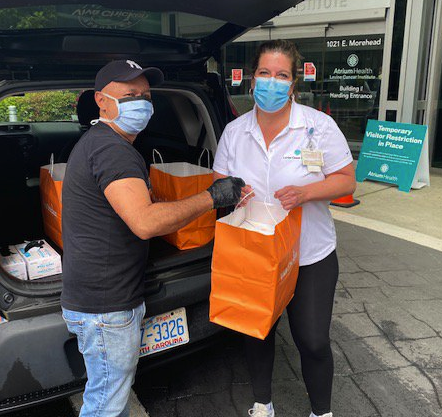
Charlotte-based Viva Chicken CEO Gerald Pulsinelli shares five strategies that has breathed new life into the chain amid the coronavirus.
 Chef Bruno Macchiavello loads up a delivery order. Photos provided.
Chef Bruno Macchiavello loads up a delivery order. Photos provided.
Since opening the first Viva Chicken in 2013 in Charlotte, the Peruvian chicken chain has added 11 restaurants featuring recipes handed down by Chef Bruno Macchiavello’s Lima-based family. Although it has always been pretty easy to convince customers to embrace the brand’s specialty offering, Pollo a la Brasa, which is rotisserie Peruvian chicken, sales dipped 70% in April when the coronavirus forced customers to shelter in place.
“As with most restaurants, we felt the effects of COVID-19 early on as traffic fluctuated and everyone tried to figure out how to navigate the pandemic,” CEO Gerald Pulsinelli told FastCasual in a recent interview. “Unfortunately, we had to furlough 50% of our team members initially.”
The chain also cut the salaries of its leadership management teams as well as hourly workers.
“Hourly pay cuts occurred, so we could keep as many people as we could on payroll, Pulsinelli said. “Fortunately, we were able to mobilize to update store hours, to evolve our tech (app and online ordering) and to become extra proficient in pickup and to-go orders. The entire team felt the impacts.”
Chicken Viva, however, is alive.
Although revenues remain down compared to this time last year, they are now only in the single digits, which Pulsinelli attributed to a nimble operations strategy.
“We were able to swiftly pivot, enhancing our app and online ordering system, adding contactless payment, curbside pick-up and grab-and-go options for our customers,” he said. “Due to the nimbleness of our team and loyalty of our customers, we were able to stabilize sales and feel good about our business despite the challenges brought on by COVID-19.”
Although curbside and to-go orders had always been available at Viva Chicken, the pandemic forced it to explore its use of technology tech to better meet customer needs. Since April, the chain has added:
- App and online ordering updates.
- Text paging to notify guests of their order status.
- Customer-facing credit card readers for contactless payment.
- Curbside ordering via tablets available at all locations soon.
- Grab-and-go areas.
“I wish I could say we had a pandemic emergency fund set up,” Pulsinelli said. “We knew that Viva had to adapt to keep our stores open and teammates employed, so we found money in the budget to fund these upgrades.”
To stay afloat, Pulsinelli and his team also took advantage of the Paycheck Protection Program.
“We were able to use it in the ‘right’ way,” said Pulsinelli, not commenting on the amount the chain received. “We did so by bringing valued team members back from being furloughed, paying rent for our 12 locations as well as paying utilities.”
It was important to the leadership team to use the money to reinstate the full salaries of its more than 500 employees.
“As sales have returned, we have been able to go back and retroactively pay the management teams’ bonuses,” Pulsinelli said. “We went back and made up for our team members’ lost wages. We paid the hourly team and management teams a bonus.”
Moving forward
Although everyone hopes the pandemic will eventually be in the rear-view mirror, Pulsinelli said its effects will be everlasting with customers staying hyper-conscious of health and safety for the foreseeable future.
“As restaurants begin reopening with increased capacity, we’ll keep this top of mind to ensure everyone visiting a Viva location has a pleasurable and safe experience,” he said. “I also think COVID-19 will force restaurants to have detailed emergency plans and thoughtful design and amenities (like ghost kitchens) in the event something unforeseen like this happens again.”
Pulsinelli expects catering and dine-in business to come back, but he’ll continue to leverage carry-out, delivery and grab-and-go areas.
“People’s habits will continue to change and restaurants especially in the fast casual sector will continue to evolve,” he said.
click here to view original article via Fast Casual


